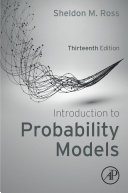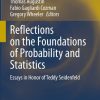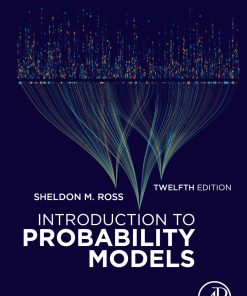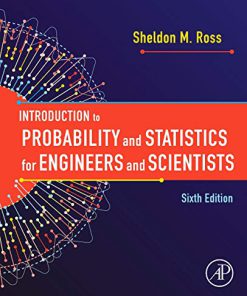Introduction to Probability Models 13th Edition by Sheldon M Ross ISBN 9780443187612 0443187614
$50.00 Original price was: $50.00.$25.00Current price is: $25.00.
Introduction to Probability Models 13th Edition by Sheldon M Ross – Ebook PDF Instant Download/Delivery: 9780443187612 ,0443187614
Full download Introduction to Probability Models 13th Edition after payment

Product details:
ISBN 10: 0443187614
ISBN 13: 9780443187612
Author: Sheldon M Ross
Introduction to Probability Models: Thirteenth Edition is available in two manageable volumes: an Elementary edition appropriate for undergraduate use and an Advanced edition for graduate use. Together, and through their hallmark exercises and real examples, both versions offer a comprehensive foundation of this key subject with applications across engineering, computer science, management science, the physical and social sciences and operations research. Users will find comprehensive information that introduces them to the foundations of probability modeling and stochastic processes from Random Variables, to Markov Chains and Renewal Theory.
Introduction to Probability Models 13th Edition Table of contents:
1: Introduction to Probability Theory
1.1. Introduction
1.2. Sample Space and Events
1.3. Probabilities Defined on Events
1.4. Conditional Probabilities
1.5. Independent Events
1.6. Bayes’ Formula
1.7. Probability Is a Continuous Event Function
Exercises
References
2: Random Variables
2.1. Random Variables
2.2. Discrete Random Variables
2.3. Continuous Random Variables
2.4. Expectation of a Random Variable
2.5. Jointly Distributed Random Variables
2.6. Moment Generating Functions
2.7. Limit Theorems
2.8. Proof of the Strong Law of Large Numbers
2.9. Stochastic Processes
Exercises
References
3: Conditional Probability and Conditional Expectation
3.1. Introduction
3.2. The Discrete Case
3.3. The Continuous Case
3.4. Computing Expectations by Conditioning
3.5. Computing Probabilities by Conditioning
3.6. Some Applications
3.7. An Identity for Compound Random Variables
Exercises
4: Markov Chains
4.1. Introduction
4.2. Chapman–Kolmogorov Equations
4.3. Classification of States
4.4. Long-Run Proportions and Limiting Probabilities
4.5. Some Applications
4.6. Mean Time Spent in Transient States
4.7. Branching Processes
4.8. Time Reversible Markov Chains
4.9. Markov Chain Monte Carlo Methods
4.10. Markov Decision Processes
4.11. Hidden Markov Chains
Exercises
References
5: The Exponential Distribution and the Poisson Process
5.1. Introduction
5.2. The Exponential Distribution
5.3. The Poisson Process
5.4. Generalizations of the Poisson Process
5.5. Random Intensity Functions and Hawkes Processes
Exercises
References
6: Continuous-Time Markov Chains
6.1. Introduction
6.2. Continuous-Time Markov Chains
6.3. Birth and Death Processes
6.4. The Transition Probability Function Pij(t)
6.5. Limiting Probabilities
6.6. Time Reversibility
6.7. The Reversed Chain
6.8. Uniformization
6.9. Computing the Transition Probabilities
Exercises
References
7: Renewal Theory and Its Applications
7.1. Introduction
7.2. Distribution of N(t)
7.3. Limit Theorems and Their Applications
7.4. Renewal Reward Processes
7.5. Regenerative Processes
7.6. Semi-Markov Processes
7.7. The Inspection Paradox
7.8. Computing the Renewal Function
7.9. Applications to Patterns
7.10. The Insurance Ruin Problem
Exercises
References
8: Queueing Theory
8.1. Introduction
8.2. Preliminaries
8.3. Exponential Models
8.4. Network of Queues
8.5. The System M/G/1
8.6. Variations on the M/G/1
8.7. The Model G/M/1
8.8. A Finite Source Model
8.9. Multiserver Queues
Exercises
9: Reliability Theory
9.1. Introduction
9.2. Structure Functions
9.3. Reliability of Systems of Independent Components
9.4. Bounds on the Reliability Function
9.5. System Life as a Function of Component Lives
9.6. Expected System Lifetime
9.7. Systems with Repair
Exercises
References
10: Brownian Motion and Stationary Processes
10.1. Brownian Motion
10.2. Hitting Times, Maximum Variable, and the Gambler’s Ruin Problem
10.3. Variations on Brownian Motion
10.4. Pricing Stock Options
10.5. The Maximum of Brownian Motion with Drift
10.6. White Noise
10.7. Gaussian Processes
10.8. Stationary and Weakly Stationary Processes
10.9. Harmonic Analysis of Weakly Stationary Processes
Exercises
References
11: Simulation
11.1. Introduction
11.2. General Techniques for Simulating Continuous Random Variables
11.3. Special Techniques for Simulating Continuous Random Variables
11.4. Simulating from Discrete Distributions
11.5. Stochastic Processes
11.6. Variance Reduction Techniques
11.7. Determining the Number of Runs
11.8. Generating from the Stationary Distribution of a Markov Chain
Exercises
References
12: Coupling
12.1. A Brief Introduction
12.2. Coupling and Stochastic Order Relations
12.3. Stochastic Ordering of Stochastic Processes
12.4. Maximum Couplings, Total Variation Distance, and the Coupling Identity
12.5. Applications of the Coupling Identity
12.6. Coupling and Stochastic Optimization
12.7. Chen–Stein Poisson Approximation Bounds
Exercises
13: Martingales
13.1. Introduction
13.2. The Martingale Stopping Theorem
13.3. Applications of the Martingale Stopping Theorem
13.4. Submartingales
People also search for Introduction to Probability Models 13th Edition:
introduction to probability models by sheldon m ross pdf
ross sm 2019 introduction to probability models academic press
ross introduction to probability models 11th edition
ross introduction to probability models 12th edition pdf
ross sm introduction to probability models pdf
Tags: Sheldon M Ross, Introduction, Probability Models
You may also like…
Uncategorized
Introduction to Probability 2nd Edition by Joseph Blitzstein, Jessica Hwang 1138369918 9781138369917
Business & Economics - Sales & Marketing
Mathematics - Probability
Introduction to Probability Models 12th Edition Sheldon M Ross
Mathematics - Probability
An introduction to probability and statistics using BASIC First Edition Groeneveld
Mathematics - Probability
Introduction to Probability and Statistics for Engineers and Scientists, 6th Edition Sheldon M. Ross
Mathematics - Others











